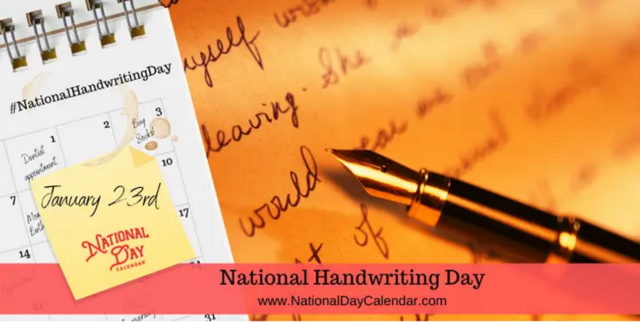
National Handwriting Day was started to re-introduce one’s self to a pen or pencil and a piece of paper. According to the Writing Instrument Manufacturers Association, it is a chance for all to re-explore the purity and power of handwriting.
- National Handwriting Day was established by the Writing Instrument Manufacturers Association in 1977. Their motive is to promote the consumption of pens, pencils and writing paper. January 23rd was chosen as this is the birthday of John Hancock.
- John Hancock was the first person to sign the Declaration of Independence.
- Handwriting That Slants Upwards – Does your writing slant up as the sentence graduates? As Dr. Darius Russin says, this could represent high levels of ambition. “But be careful,” he says. “This could also be [a] sign of arrogance.”
- Found on clay tablets from Mesopotamia, the first ever recorded handwriting dates back to 3,300BC.
- Handwriting was first used for list making
- One of the oldest pieces of handwriting stored at the British Museum is a list of beer rations allocated to building workers
- QUIZ: Can you guess what 97 per cent of people write when they are trying out a new pen for the first time?! (Answer is further down)
- According to the history books U.S. president James Garfield was super talented when it came to handwriting! As well as being ambidextrous Garfield could apparently write in Greek with one hand whilst writing in Latin with the other!
- “Leonardo da Vinci used to write most of his stuff in mirror handwriting, unless it needed to be read by others.” This fact is backed up by this BBC research that says that Da Vinci wrote in a ‘left handed mirror script’. This means he wrote everything backwards,
- Answer: When trying out a new pen for the first time 97 per cent of people write their own name!
- Letter size: Small letters generally indicate shyness or introversion whereas large letters might indicate extroversion or a need for attention. Average-sized letters indicate a well-adjusted and adaptable person.
- Slanting: Those who write their letters in a neutral and upright position are said to be logical and practical. A forward-aiming, right slant usually indicates an openness to new people and experiences. A slant to the left or backwards could mean you like to keep to yourself—though if you’re right-handed and do this, it could just mean you’re rebellious!
- Letter shapes: Rounded letters might show a creative or artistic bent, whereas sharp and pointed lettering shows aggressiveness and intensity. Finally, smooth and connected letters might reveal a systematic and logical thinker.
- Dotted I’s: The position of the dot over the i may reveal more than you think. Directly above generally means you’re an organized and detail-oriented person whereas one slightly to the left might mean you’re a procrastinator. Someone who does deliberate circles over their i’s might even be a creative visionary!
- Crossing T’s: Those who cross high on their t’s are considered optimistic and high in self-esteem, while those cross lower may have lower self-expectations—the middle may be just right! Similarly, longer crosses might show determination and enthusiasm while shorter crosses might show a streak of laziness.
- Lowercase S’s: Those sneaky s’s can also tell you quite a lot. Those who round out their s’s are likely to be people pleasers who want to avoid confrontations. Pointy or sharp lowercase s’s may indicate ambition or inquisitiveness. Finally, smaller s’s that are wide on the bottom may mean that the writer is not following their truest dreams.
- Speed: Fast writers are unlikely to be time-wasters—they emphasize efficiency and might be impatient. On the other hand, slow writers are more likely to be methodical and deliberate. They may also be better organized!
Sources:












